Monthly Scale Validation of Climate Models’ Outputs Against Gridded Data over South Africa
Abstract
1. Introduction
Study Area
2. Materials and Methods
2.1. Observational Data
2.2. Simulation Data
3. Methodology
3.1. Spatial Validation Using the Monthly Mean Bias Maps
3.2. Statistical Validation of Monthly Mean Fields
4. Results and Discussion
4.1. Mean Temperature Bias Patterns and Model Output Patterns
4.2. Statistical Analysis of the Metrics for the Monthly Mean Temperature Fields
4.3. Analysis of the Monthly Mean Precipitation Bias Maps
4.4. Statistical Analysis of the Metrics for the Monthly Mean Precipitation Fields
4.5. Limitations
5. Conclusions
Supplementary Materials
Author Contributions
Funding
Institutional Review Board Statement
Informed Consent Statement
Data Availability Statement
Conflicts of Interest
References
- Voldoire, A. Climate models. Comptes Rendus Mec. 2022, 350, 219–232. [Google Scholar] [CrossRef]
- Tapiador, F.J. Validation of Climate Models. In Satellite Precipitation Measurement; Levizzani, V., Kidd, C., Kirschbaum, D., Kummerow, C., Nakamura, K., Turk, F., Eds.; Springer: Cham, Switzerland, 2020; Volume 69. [Google Scholar] [CrossRef]
- Hewer, M.J.; Beech, N.; Gough, W.A. Development and validation of the Climate Model Confidence Index (CMCI): Measuring ability to reproduce historical climate conditions. Theor. Appl. Clim. 2021, 144, 1059–1075. [Google Scholar] [CrossRef]
- Dosio, A.; Jury, M.W.; Almazroui, M.; Ashfaq, M.; Diallo, I.; Engelbrecht, F.A.; Klutse, N.A.B.; Lennard, C.; Pinto, I.; Sylla, M.B.; et al. Projected future daily characteristics of African precipitation based on global (CMIP5, CMIP6) and regional (CORDEX, CORDEX-CORE) climate models. Clim. Dyn. 2021, 57, 3135–3158. [Google Scholar] [CrossRef]
- Gyamfi, C.; Tindan, J.Z.-O.; Kifanyi, G.E. Evaluation of CORDEX Africa multi-model precipitation simulations over the Pra River Basin, Ghana. J. Hydrol. Reg. Stud. 2021, 35, 100815. [Google Scholar] [CrossRef]
- Omay, P.O.; Muthama, N.J.; Oludhe, C.; Kinama, J.M.; Artan, G.; Atheru, Z. Evaluation of CMIP6 historical simulations over IGAD region of Eastern Africa. Discov. Environ. 2023, 1, 11. [Google Scholar] [CrossRef]
- Harris, I.; Osborn, T.J.; Jones, P.; Lister, D. Version 4 of the CRU TS monthly high-resolution gridded multivariate climate dataset. Sci. Data 2020, 7, 109. [Google Scholar] [CrossRef] [PubMed]
- Karypidou, M.C.; Katragkou, E.; Sobolowski, S.P. Precipitation over southern Africa: Is there consensus among global climate models (GCMs), regional climate models (RCMs) and observational data? Geosci. Model Dev. 2022, 15, 3387–3404. [Google Scholar] [CrossRef]
- Li, Z.; Liu, T.; Huang, Y.; Peng, J.; Ling, Y. Evaluation of the CMIP6 precipitation simulations over global land. Earth’s Futur. 2022, 10, e2021EF002500. [Google Scholar] [CrossRef]
- Doumbia, B.; Adefisan, E.; Omotosho, J.; Thies, B. Evaluation of CMIP5 and CMIP6 performance in simulating West African precipitation. In Digital Technologies and Applications, Proceedings of the International Conference on Digital Technologies and Applications, ICDTA 2023, Fez, Morocco, 27–28 January 2023; Motahhir, S., Bossoufi, B., Eds.; Springer: Cham, Switzerland, 2023; Volume 668. [Google Scholar] [CrossRef]
- Babaousmail, H.; Hou, R.; Ayugi, B.; Ojara, M.; Ngoma, H.; Karim, R.; Rajasekar, A.; Ongoma, V. Evaluation of the performance of CMIP6 models in reproducing rainfall patterns over North Africa. Atmosphere 2021, 12, 475. [Google Scholar] [CrossRef]
- Gebrehiwot, G.H.; Bekitie, K.T.; Abiko, F.; Seifu, W.; Gebremichael, H.B. Evaluation of CORDEX-Africa model data reliability and bias correction for climate change impact assessment: Upper Tekeze River Basin, Tigray (Ethiopia). Green Low-Carbon Econ. 2024, 1–12. [Google Scholar] [CrossRef]
- Ignatov, A. South Africaʼs Just Energy Transition: Issues and Prospects. Int. Organ. Res. J. 2023, 18, 124–146. [Google Scholar] [CrossRef]
- Williams, K.D.; Copsey, D.; Blockley, E.W.; Bodas-Salcedo, A.; Calvert, D.; Comer, R.; Davis, P.; Graham, T.; Hewitt, H.T.; Hill, R.; et al. The Met Office Global Coupled Model 3.0 and 3.1 (GC3.0 and GC3.1) configurations. J. Adv. Model. Earth Syst. 2017, 10, 357–380. [Google Scholar] [CrossRef]
- Collins, W.J.; Bellouin, N.; Doutriaux-Boucher, M.; Gedney, N.; Halloran, P.; Hinton, T.; Hughes, J.; Jones, C.D.; Joshi, M.; Liddicoat, S.; et al. Development and evaluation of an Earth-System model—HadGEM2. Geosci. Model Dev. 2011, 4, 1051–1075. [Google Scholar] [CrossRef]
- Müller, W.A.; Jungclaus, J.H.; Mauritsen, T.; Baehr, J.; Bittner, M.; Budich, R.; Bunzel, F.; Esch, M.; Ghosh, R.; Haak, H.; et al. A higher-resolution version of the Max Planck Institute Earth System Model (MPI-ESM1.2-HR). J. Adv. Model. Earth Syst. 2018, 10, 1383–1413. [Google Scholar] [CrossRef]
- Giorgetta, M.A.; Jungclaus, J.; Reick, C.H.; Legutke, S.; Bader, J.; Böttinger, M.; Brovkin, V.; Crueger, T.; Esch, M.; Fieg, K.; et al. Climate and carbon cycle changes from 1850 to 2100 in MPI-ESM simulations for the Coupled Model Intercomparison Project phase 5. J. Adv. Model. Earth Syst. 2013, 5, 572–597. [Google Scholar] [CrossRef]
- Seland, Ø.; Bentsen, M.; Olivié, D.; Toniazzo, T.; Gjermundsen, A.; Graff, L.S.; Debernard, J.B.; Gupta, A.K.; He, Y.-C.; Kirkevåg, A.; et al. Overview of the Norwegian Earth System Model (NorESM2) and key climate response of CMIP6 DECK, historical, and scenario simulations. Geosci. Model Dev. 2020, 13, 6165–6200. [Google Scholar] [CrossRef]
- Bentsen, M.; Bethke, I.; Debernard, J.B.; Iversen, T.; Kirkevåg, A.; Seland, Ø.; Drange, H.; Roelandt, C.; Seierstad, I.A.; Hoose, C.; et al. The Norwegian Earth System Model, NorESM1-M—Part 1: Description and basic evaluation of the physical climate. Geosci. Model Dev. 2013, 6, 687–720. [Google Scholar] [CrossRef]
- Rockel, B.; Will, A.; Hense, A. The regional climate model COSMO-CLM (CCLM). Meteorol. Z. 2008, 17, 347–348. [Google Scholar] [CrossRef]
- Jacob, D.; Petersen, J.; Eggert, B.; Alias, A.; Christensen, O.B.; Bouwer, L.M.; Braun, A.; Colette, A.; Déqué, M.; Georgievski, G.; et al. EURO-CORDEX: New high-resolution climate change projections for European impact research. Reg. Environ. Change 2014, 14, 563–578. [Google Scholar] [CrossRef]
- Giorgi, F.; Coppola, E.; Solmon, F.; Mariotti, L.; Sylla, M.B.; Bi, X.; Elguindi, N.; Diro, G.T.; Nair, V.; Giuliani, G.; et al. RegCM4: Model description and preliminary tests over multiple CORDEX domains. Clim. Res. 2012, 52, 7–29. [Google Scholar] [CrossRef]
- Adelodun, B.; Ahmad, M.J.; Odey, G.; Adeyi, Q.; Choi, K.S. Performance-based evaluation of cmip5 and cmip6 global climate models and their multi-model ensembles to simulate and project seasonal and annual climate variables in the Chungcheong Region of South Korea. Atmosphere 2023, 14, 1569. [Google Scholar] [CrossRef]
- R Core Team. R: A Language and Environment for Statistical Computing; R Foundation for Statistical Computing: Vienna, Austria, 2021; Available online: https://www.R-project.org/ (accessed on 9 June 2024).
- Taylor, K.E. Summarizing multiple aspects of model performance in a single diagram. J. Geophys. Res. Atmos. 2001, 106, 7183–7192. [Google Scholar] [CrossRef]
- Li, J.; Xu, K.; Wang, W.; He, Z.; Huang, K. Biases and improvements of the boreal winter–spring equatorial undercurrent in the Indian Ocean in the CMIP5 and CMIP6 models. Front. Mar. Sci. 2023, 10, 1168385. [Google Scholar] [CrossRef]
- Maccali, J.; Meckler, A.N.; Lauritzen, S.-E.; Brekken, T.; Rokkan, H.A.; Fernandez, A.; Krüger, Y.; Adigun, J.; Affolter, S.; Leuenberger, M. Multi-proxy speleothem-based reconstruction of mid-MIS 3 climate in South Africa. Clim. Past 2023, 19, 1847–1862. [Google Scholar] [CrossRef]
- Aloysius, N.R.; Sheffield, J.; Saiers, J.E.; Li, H.; Wood, E.F. Evaluation of historical and future simulations of precipitation and temperature in central Africa from CMIP5 climate models. J. Geophys. Res. Atmos. 2015, 121, 130–152. [Google Scholar] [CrossRef]
- Fredriksen, B.; Smith, C.J.; Modak, A.; Rugenstein, M. 21st Century scenario forcing increases more for CMIP6 than CMIP5 models. Geophys. Res. Lett. 2023, 50, e2023GL102916. [Google Scholar] [CrossRef]
- Nikiema, P.M.; Sylla, M.B.; Ogunjobi, K.; Kebe, I.; Gibba, P.; Giorgi, F. Multi-model CMIP5 and CORDEX simulations of historical summer temperature and precipitation variabilities over West Africa. Int. J. Clim. 2016, 37, 2438–2450. [Google Scholar] [CrossRef]
- Farah, K.H.; Sime, C.H.; Hassen, A.M.; Muhumed, U.M. Assessment of RCA4, CORDEX Africa domains RCMs performance in simulating rainfall and temperature: A case of Gilgal Gibe watershed, Ethiopia. EarthArXiv 2024. [Google Scholar] [CrossRef]
- Koseki, S.; Demissie, T. Does the Drakensberg dehydrate southwestern Africa? J. Arid. Environ. 2018, 158, 35–42. [Google Scholar] [CrossRef]
- Ongoma, V.; Chen, H.; Gao, C. Evaluation of CMIP5 twentieth century rainfall simulation over the equatorial East Africa. Theor. Appl. Clim. 2019, 135, 893–910. [Google Scholar] [CrossRef]
- Samuel, S.; Dosio, A.; Mphale, K.; Faka, D.N.; Wiston, M. Comparison of multimodel ensembles of global and regional climate models projections for extreme precipitation over four major river basins in southern Africa—Assessment of the historical simulations. Clim. Change 2023, 176, 57. [Google Scholar] [CrossRef]
- Kalognomou, E.; Lennard, C.; Shongwe, M.; Pinto, I.; Favre, A.; Kent, M.; Hewitson, B.; Dosio, A.; Nikulin, G.; Panitz, H.-J.; et al. A diagnostic evaluation of precipitation in CORDEX models over Southern Africa. J. Clim. 2013, 26, 9477–9506. [Google Scholar] [CrossRef]
- Mathewos, Y.; Abate, Y.; Dadi, M. Characterization of the skill of the CORDEX-Africa regional climate models to simulate regional climate setting in the East African Transboundary Omo Gibe River Basin, Ethiopia. Heliyon 2023, 9, e20379. [Google Scholar] [CrossRef]
- Kamruzzaman, M.; Wahid, S.; Mainuddin, M.; Chiew, F.; Islam, A.R.M.T.; Hamed, M.M.; Shahid, S. Extreme precipitation projections in South Asia: A step-up from CMIP5 to CMIP6. SSRN 2024. [Google Scholar] [CrossRef]
- Bárdossy, A.; Pegram, G. Multiscale spatial recorrelation of RCM precipitation to produce unbiased climate change scenarios over large areas and small. Water Resour. Res. 2012, 48, W09502. [Google Scholar] [CrossRef]
- Tao, C.; Xie, S.; Tang, S.; Lee, J.; Ma, H.-Y.; Zhang, C.; Lin, W. Diurnal cycle of precipitation over global monsoon systems in CMIP6 simulations. Clim. Dyn. 2023, 60, 3947–3968. [Google Scholar] [CrossRef]
- Ajibola, F.O.; Zhou, B.; Gnitou, G.T.; Onyejuruwa, A. Evaluation of the Performance of CMIP6 HighResMIP on West African Precipitation. Atmosphere 2020, 11, 1053. [Google Scholar] [CrossRef]
- John, A.; Douville, H.; Ribes, A.; Yiou, P. Quantifying CMIP6 model uncertainties in extreme precipitation projections. Weather Clim. Extrem. 2022, 36, 100435. [Google Scholar] [CrossRef]
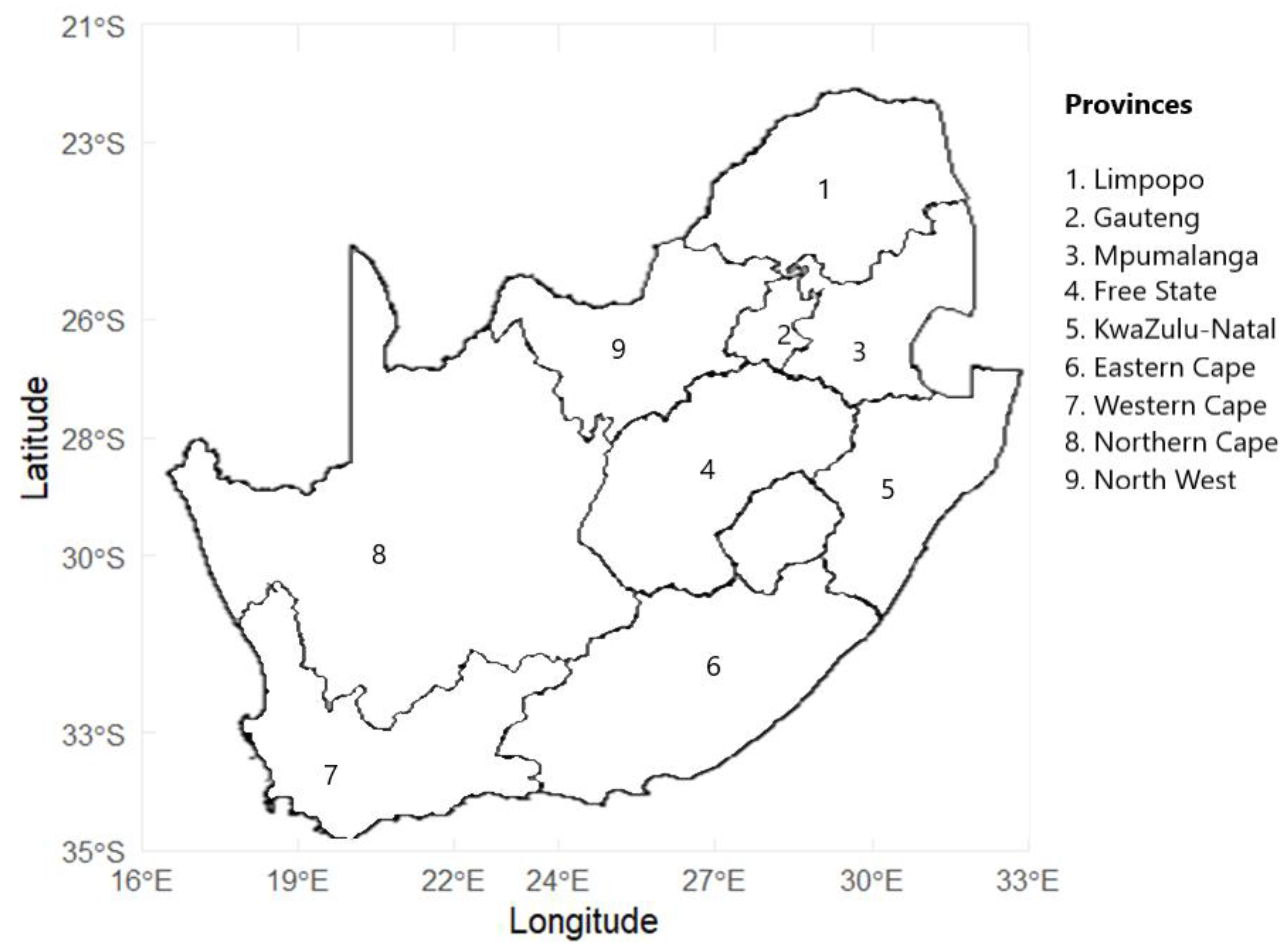
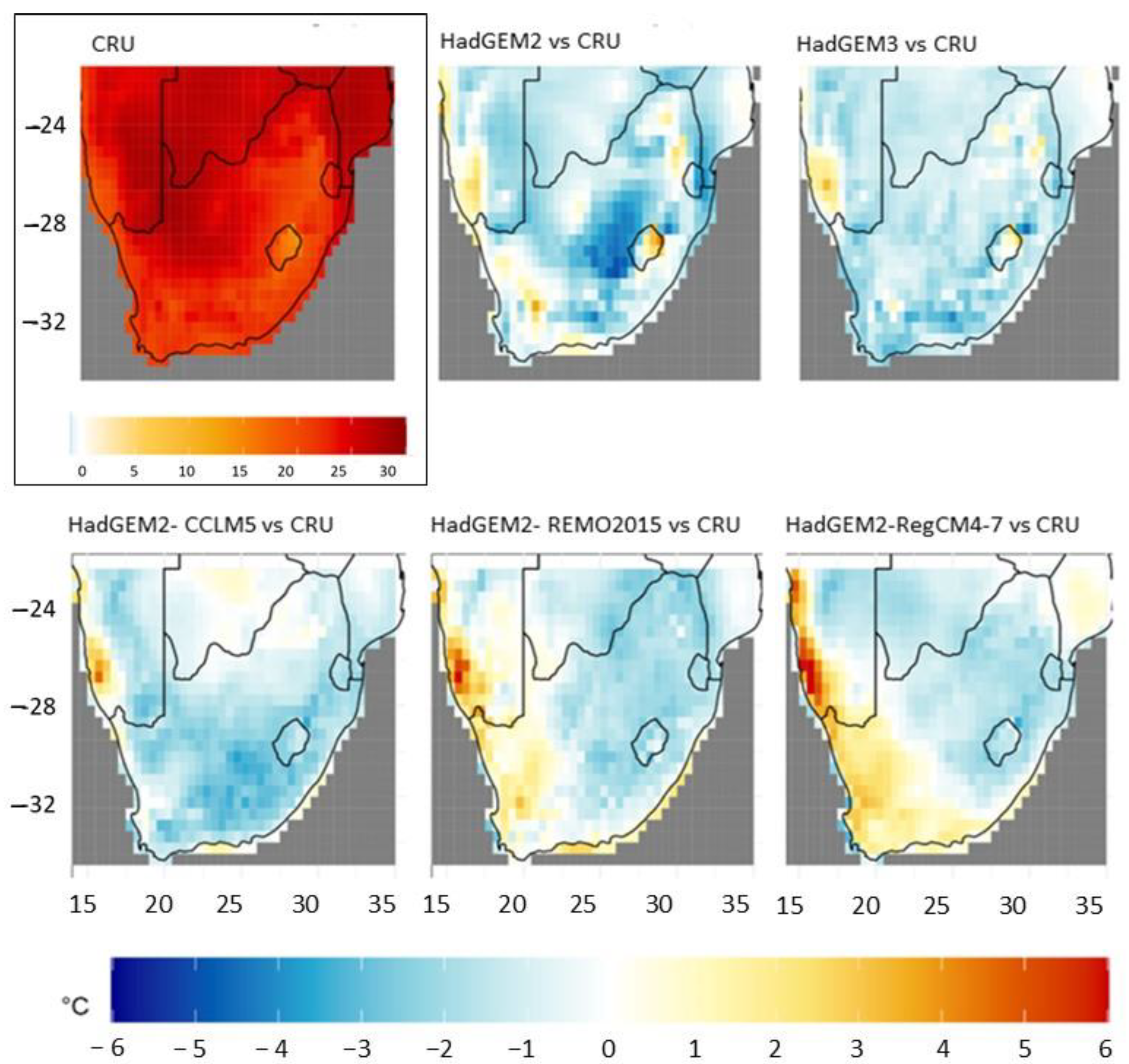
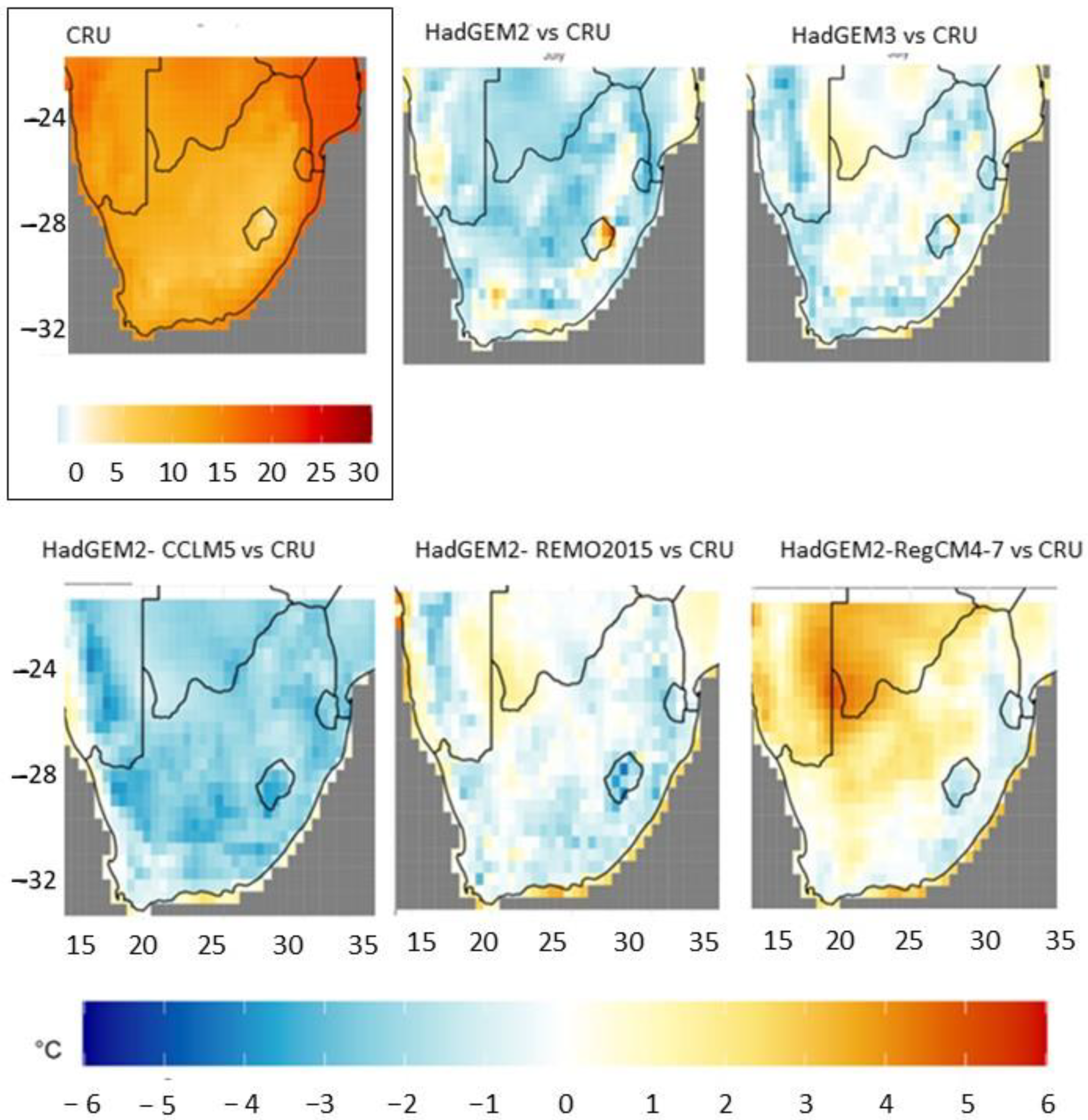
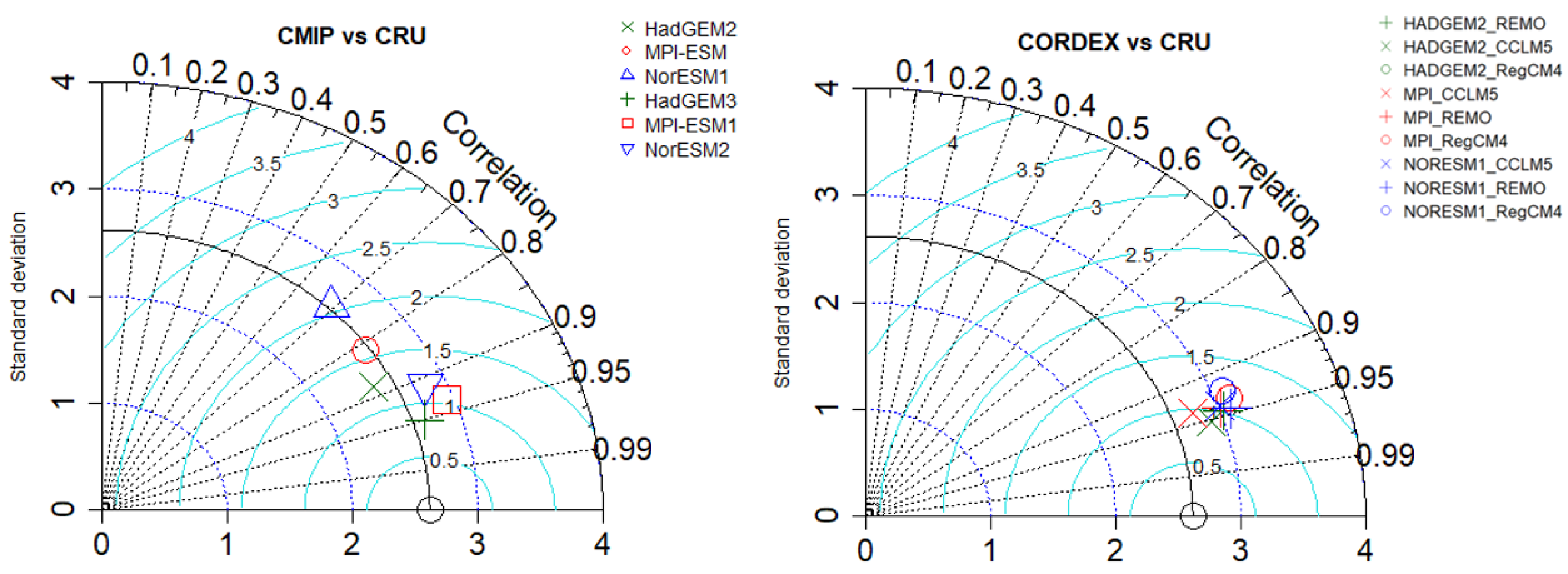
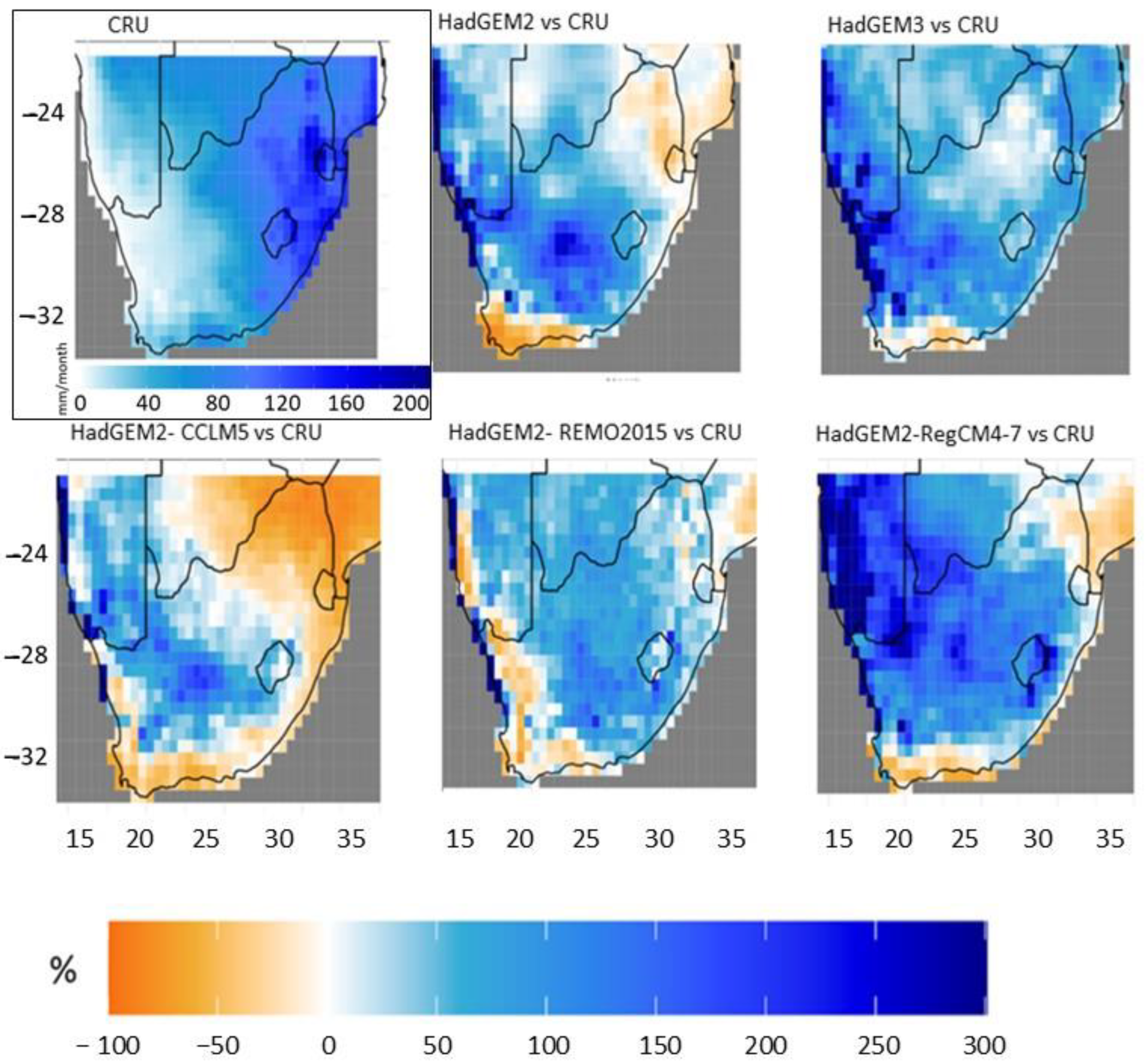
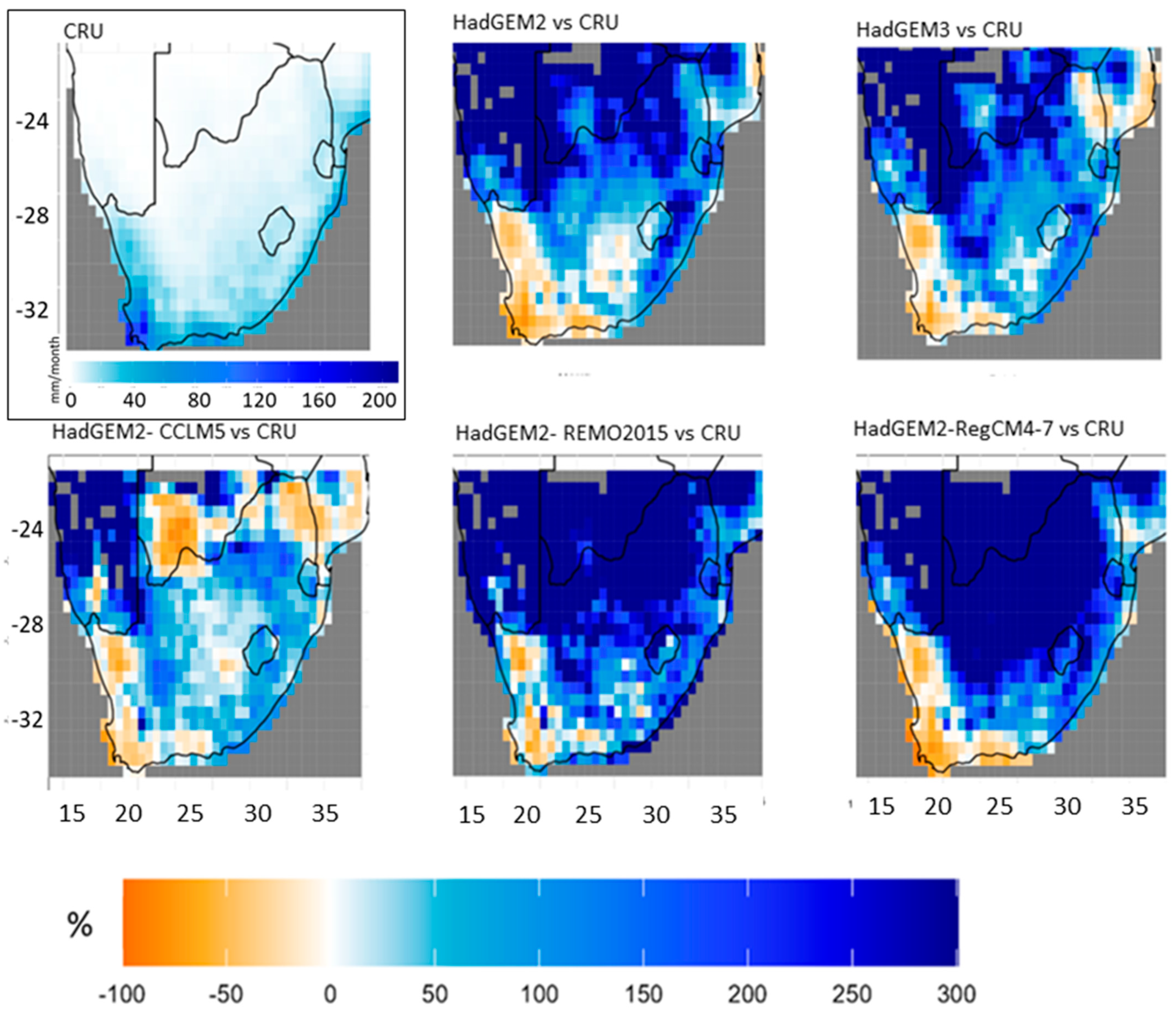

| Model | Institution | Atmospheric Model | Ocean Model | Land-Surface Model | Carbon Cycle | Reference |
|---|---|---|---|---|---|---|
| CMIP6: HadGEM3-GC31-MM | Met Office Hadley Centre (MOHC) | Global Coupled Model 3 (GC3) | Nucleus for European Modelling of the Ocean (NEMO) | Joint UK Land Environment Simulator (JULES) | advanced carbon cycle and biogeochemical processes | [14] |
| CMIP5: HadGEM2-ES | Hadley Centre Global Environment Model 2 | HadGEM2-Ocean | Met Office Surface Exchange Scheme2 (MOSES2) | carbon and chemistry | [15] | |
| CMIP6: MPI-ESM1-2-HR | Max Planck Institute for Meteorology (MPI-M) | ECHAM6.3 | MPIOM | JSBACH3.2 | interactive carbon cycle | [16] |
| CMIP5: MPI-ESM-LR | ECHAM6 | JSBACH | [17] | |||
| CMIP6: NorESM2-MM | Norwegian Climate Centre (NCC) | Community Atmosphere Model version 6 (CAM6) | Bergen Layered Ocean Model (BLOM) | CLM5 (Community Land Model version 5) | isopycnic coordinate Hamburg Ocean Carbon Cycle (iHAMOCC) | [18] |
| CMIP5: NorESM1-M | Community Atmosphere Model version 4 (CAM4) | Miami Isopycnic Coordinate Ocean Model (MICOM) | CLM4 (Community Land Model version 4) | interactive carbon cycle | [19] | |
| CORDEX: CCLM5-0-15 Driven by all three 3 CMIP5 model outputs | Climate Limited-area Modelling Community (CLM-Community) | COSMO-CLM | N/A | TERRA-ML | N/A | [20] |
| CORDEX: REMO201 5 Driven by all three 3 CMIP5 model outputs | Max Planck Institute for Meteorology (MPI-M) | REMO | Basic surface module (HydroPy) | [21] | ||
| CORDEX: RegCM4-7 Driven by all three 3 CMIP5 model outputs | International Centre for Theoretical Physics (ICTP) | RegCM4 | BATS or CLM | [22] |
| CMIP5 | CMIP6 | ||||||
|---|---|---|---|---|---|---|---|
| Month | Model | cRMSE | Correlation | Std_Dev Difference | RMSE | Correlation | Obs_Std_Dev Difference |
| December | HadGEM3 | 1.40 | 0.87 | −0.21 | 0.97 | 0.94 | 0.09 |
| December | MPI_ESM1 | 1.72 | 0.81 | −0.20 | 1.31 | 0.93 | 0.54 |
| December | NorESM2 | 2.40 | 0.64 | −0.02 | 1.53 | 0.88 | 0.41 |
| January | HadGEM3 | 1.41 | 0.86 | −0.24 | 0.92 | 0.94 | −0.05 |
| January | MPI_ESM1 | 1.96 | 0.72 | −0.23 | 1.21 | 0.91 | 0.22 |
| January | NorESM2 | 2.50 | 0.56 | −0.13 | 1.53 | 0.86 | 0.22 |
| February | HadGEM3 | 1.49 | 0.83 | 0.00 | 0.96 | 0.93 | −0.02 |
| February | MPI_ESM1 | 2.03 | 0.68 | −0.11 | 1.42 | 0.85 | 0.03 |
| February | NorESM2 | 2.35 | 0.55 | −0.18 | 1.40 | 0.87 | 0.26 |
| March | HadGEM3 | 1.39 | 0.85 | −0.12 | 0.95 | 0.93 | −0.02 |
| March | MPI_ESM1 | 1.98 | 0.70 | −0.18 | 1.43 | 0.86 | 0.16 |
| March | NorESM2 | 2.27 | 0.60 | −0.19 | 1.37 | 0.88 | 0.28 |
| April | HadGEM3 | 1.39 | 0.86 | −0.15 | 0.92 | 0.94 | −0.03 |
| April | MPI_ESM1 | 1.74 | 0.79 | −0.13 | 1.31 | 0.90 | 0.24 |
| April | NorESM2 | 2.21 | 0.66 | −0.10 | 1.28 | 0.90 | 0.24 |
| May | HadGEM3 | 1.31 | 0.89 | 0.06 | 0.95 | 0.95 | 0.09 |
| May | MPI_ESM1 | 1.58 | 0.86 | 0.30 | 1.16 | 0.95 | 0.60 |
| May | NorESM2 | 1.89 | 0.78 | 0.04 | 1.32 | 0.90 | 0.16 |
| June | HadGEM3 | 1.22 | 0.92 | −0.11 | 1.01 | 0.95 | 0.05 |
| June | MPI_ESM1 | 1.46 | 0.89 | 0.20 | 1.04 | 0.96 | 0.41 |
| June | NorESM2 | 1.69 | 0.85 | 0.05 | 0.98 | 0.95 | 0.13 |
| July | HadGEM3 | 1.18 | 0.92 | −0.07 | 1.01 | 0.94 | 0.00 |
| July | MPI_ESM1 | 1.47 | 0.89 | 0.17 | 1.11 | 0.95 | 0.45 |
| July | NorESM2 | 2.00 | 0.78 | 0.03 | 1.15 | 0.93 | 0.08 |
| August | HadGEM3 | 1.27 | 0.90 | −0.15 | 0.95 | 0.95 | 0.20 |
| August | MPI_ESM1 | 1.47 | 0.88 | 0.19 | 1.09 | 0.95 | 0.49 |
| August | NorESM2 | 1.94 | 0.77 | 0.02 | 1.11 | 0.93 | 0.12 |
| September | HadGEM3 | 1.18 | 0.91 | −0.14 | 0.94 | 0.95 | 0.17 |
| September | MPI_ESM1 | 1.56 | 0.86 | 0.07 | 1.15 | 0.95 | 0.54 |
| September | NorESM2 | 2.13 | 0.73 | 0.04 | 1.11 | 0.94 | 0.28 |
| October | HadGEM3 | 1.30 | 0.91 | −0.03 | 0.98 | 0.95 | 0.22 |
| October | MPI_ESM1 | 1.55 | 0.88 | 0.20 | 1.27 | 0.95 | 0.71 |
| October | NorESM2 | 2.07 | 0.77 | 0.02 | 1.10 | 0.94 | 0.19 |
| November | HadGEM3 | 1.38 | 0.89 | −0.13 | 1.03 | 0.95 | 0.22 |
| November | MPI_ESM1 | 1.60 | 0.85 | −0.16 | 1.20 | 0.94 | 0.48 |
| November | NorESM2 | 2.19 | 0.74 | −0.02 | 1.43 | 0.91 | 0.34 |
| CMIP5 | CMIP6 | ||||||
|---|---|---|---|---|---|---|---|
| Month | Model | cRMSE | Correlation | Std_Dev Difference | RMSE | Correlation | Obs_Std_Dev Difference |
| December | HadGEM3 | 29.6 | 0.9 | 21.5 | 25.0 | 0.9 | 11.5 |
| December | MPI_ESM1 | 26.4 | 0.9 | 14.7 | 21.3 | 0.9 | 8.8 |
| December | NorESM2 | 65.0 | 0.9 | 55.3 | 34.1 | 0.9 | 28.4 |
| January | HadGEM3 | 30.8 | 0.8 | 7.7 | 28.9 | 0.9 | 21.5 |
| January | MPI_ESM1 | 32.4 | 0.8 | 12.3 | 29.3 | 0.8 | 9.6 |
| January | NorESM2 | 63.0 | 0.8 | 51.1 | 32.2 | 0.9 | 22.1 |
| February | HadGEM3 | 23.2 | 0.8 | −1.4 | 24.2 | 0.8 | 1.9 |
| February | MPI_ESM1 | 33.4 | 0.7 | 2.9 | 39.1 | 0.6 | 6.5 |
| February | NorESM2 | 42.3 | 0.7 | 17.5 | 27.2 | 0.8 | 7.9 |
| March | HadGEM3 | 15.8 | 0.8 | −0.3 | 20.3 | 0.8 | 6.6 |
| March | MPI_ESM1 | 27.3 | 0.8 | 14.8 | 25.7 | 0.7 | 10.9 |
| March | NorESM2 | 41.1 | 0.7 | 27.7 | 21.8 | 0.9 | 14.5 |
| April | HadGEM3 | 15.6 | 0.7 | 9.0 | 16.2 | 0.8 | 10.2 |
| April | MPI_ESM1 | 26.7 | 0.5 | 16.5 | 20.1 | 0.7 | 13.7 |
| April | NorESM2 | 25.2 | 0.5 | 15.2 | 21.8 | 0.7 | 15.9 |
| May | HadGEM3 | 14.1 | 0.6 | 5.6 | 11.8 | 0.7 | 3.5 |
| May | MPI_ESM1 | 17.9 | 0.5 | 8.4 | 13.0 | 0.7 | 5.9 |
| May | NorESM2 | 20.2 | 0.3 | 6.7 | 13.0 | 0.6 | 2.4 |
| June | HadGEM3 | 12.0 | 0.6 | −1.8 | 12.4 | 0.7 | 1.3 |
| June | MPI_ESM1 | 14.3 | 0.5 | 0.8 | 10.7 | 0.8 | 1.5 |
| June | NorESM2 | 13.3 | 0.6 | −0.4 | 10.3 | 0.7 | -3.9 |
| July | HadGEM3 | 11.4 | 0.7 | −2.9 | 9.2 | 0.8 | -2.5 |
| July | MPI_ESM1 | 13.9 | 0.5 | −2.4 | 12.5 | 0.7 | 2.2 |
| July | NorESM2 | 14.5 | 0.5 | −1.9 | 10.4 | 0.7 | -5.4 |
| August | HadGEM3 | 12.3 | 0.7 | 3.7 | 12.4 | 0.8 | 5.6 |
| August | MPI_ESM1 | 18.4 | 0.6 | 9.2 | 13.2 | 0.7 | 5.9 |
| August | NorESM2 | 19.3 | 0.5 | 9.1 | 8.1 | 0.8 | -2.0 |
| September | HadGEM3 | 16.7 | 0.8 | 10.9 | 14.5 | 0.9 | 10.2 |
| September | MPI_ESM1 | 13.2 | 0.8 | 7.0 | 16.4 | 0.9 | 12.1 |
| September | NorESM2 | 24.5 | 0.7 | 16.9 | 11.6 | 0.8 | 5.2 |
| October | HadGEM3 | 18.1 | 0.9 | 10.6 | 18.3 | 0.9 | 13.0 |
| October | MPI_ESM1 | 13.2 | 0.9 | 3.5 | 18.0 | 0.9 | 6.4 |
| October | NorESM2 | 33.1 | 0.9 | 26.6 | 15.6 | 0.9 | 4.2 |
| November | HadGEM3 | 27.5 | 0.9 | 20.0 | 28.8 | 0.9 | 23.1 |
| November | MPI_ESM1 | 20.9 | 0.9 | 15.5 | 21.4 | 0.9 | 9.5 |
| November | NorESM2 | 48.6 | 0.9 | 42.9 | 26.9 | 0.9 | 20.5 |
Disclaimer/Publisher’s Note: The statements, opinions and data contained in all publications are solely those of the individual author(s) and contributor(s) and not of MDPI and/or the editor(s). MDPI and/or the editor(s) disclaim responsibility for any injury to people or property resulting from any ideas, methods, instructions or products referred to in the content. |
© 2025 by the authors. Licensee MDPI, Basel, Switzerland. This article is an open access article distributed under the terms and conditions of the Creative Commons Attribution (CC BY) license (https://creativecommons.org/licenses/by/4.0/).
Share and Cite
Chauke, H.; Pongrácz, R. Monthly Scale Validation of Climate Models’ Outputs Against Gridded Data over South Africa. Atmosphere 2025, 16, 1200. https://doi.org/10.3390/atmos16101200
Chauke H, Pongrácz R. Monthly Scale Validation of Climate Models’ Outputs Against Gridded Data over South Africa. Atmosphere. 2025; 16(10):1200. https://doi.org/10.3390/atmos16101200
Chicago/Turabian StyleChauke, Helga, and Rita Pongrácz. 2025. "Monthly Scale Validation of Climate Models’ Outputs Against Gridded Data over South Africa" Atmosphere 16, no. 10: 1200. https://doi.org/10.3390/atmos16101200
APA StyleChauke, H., & Pongrácz, R. (2025). Monthly Scale Validation of Climate Models’ Outputs Against Gridded Data over South Africa. Atmosphere, 16(10), 1200. https://doi.org/10.3390/atmos16101200






